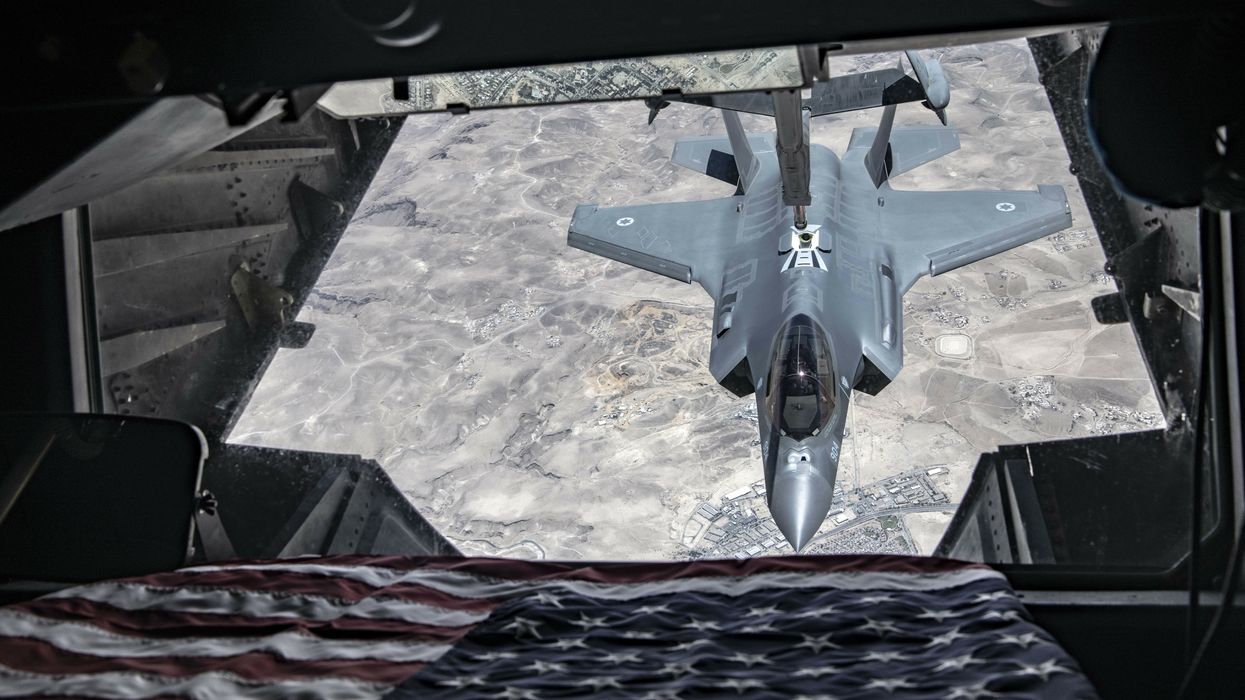The Bunker appears originally at the Project on Government Oversight and is republished here with permission.
The USS Diego Garcia
It’s not every day the U.S. military concentrates one of its most powerful weapons on a tiny island far from nowhere. After all, their vulnerability renders them a tempting target for troublemakers. But that’s just what the Pentagon has done, dispatching at least six B-2 bombers to desolate Diego Garcia in the middle of the Indian Ocean. That speck of land, 1,000 miles from anywhere, is basically an aircraft carrier that can’t move. Given that the radar-eluding B-2 has a readiness rate of just over 50%, sending six of the 19 in the Air Force’s inventory represents about half of the operational B-2 fleet’s firepower on an island smaller than Manhattan.
The $2 billion (each!) B-2s have been attacking Houthi rebels in Yemen, which is about as gross an example of “overmatch” as you can get. But the Houthis are aligned with Iran, and the U.S. is far more interested in sending Tehran a message than pulverizing second-rate Houthi military assets.
The message is this: The B-2 is the only warplane that can carry the GBU-57B Massive Ordnance Penetrator. These 30,000-pound blasting behemoths are ideal for attacking Iran’s buried nuclear-development sites. President Trump has demanded that Tehran negotiate an end to its nuclear-bomb development efforts. “If they don’t make a deal, there will be bombing,” Trump said on March 30. “It will be bombing the likes of which they have never seen before.” In turn, Iran is said to be weighing an attack on Diego Garcia. U.S. assets and roughly 4,000 largely-U.S. personnel stationed there run the “risk of complete destruction” if the U.S. attacks Iran, according to an Iranian military news outlet.
“If diplomacy fails, the next stage is likely war,” Axios reported April 8. “Bombs vs. diplomacy on Iran is a live debate within the Trump administration and the wider MAGA world.”
There’s lots of reasons this won’t happen. There are robust U.S. defenses protecting Diego Garcia, plus any such move by Iran runs the risk of a wider war. Then again, so did Trump’s decision to kill Qasem Soleimani, a senior Iranian general and terror boss, in 2020. But Trump was willing to take that risk, and, after minor-league retaliation by Tehran, the two sides resumed their tense, uneasy relationship. Best to keep those trigger-fingers crossed.
The world turned upside down
Defense Secretary Pete Hegseth reportedly will be MIA when 50 nations gather in Brussels April 11 to coordinate military aid to Ukraine. It will mark the first time the group meets without the U.S. secretary of defense since the creation of the Ukraine Defense Contact Group after Russia invaded Ukraine three years ago.
The group has given Ukraine more than $126 billion (PDF) in military aid, half of which has come from the U.S. (although there is no new U.S. aid planned). The reinforcements have helped Ukraine keep its capital of Kyiv and 80% of its territory. Russian leader Vladimir Putin had hoped to conquer the country within weeks.
The SECDEF’s vanishing act takes place as Putin keeps pounding Ukraine while thwarting Trump’s efforts for a ceasefire. It is a shameful repudiation of the U.S.’s historical support of freedom over tyranny. It’s also a marked change from Trump’s 2023 rhetoric when he warned the Russian leader to end the war. “I would tell Putin: If you don’t make a deal, we’re going to give them [the Ukrainians] a lot,” he said. “We’re going to give them more than they ever got, if we have to.”
In an eerie echo, on April 2 Trump told Axios that Moscow was missing because existing U.S. sanctions on Russia “preclude any meaningful trade.” Yet the $3.5 billion in U.S.-Russia commerce last year topped total U.S. trade with countries like Brunei and Mauritius that Trump slapped with tariffs.
The Bunker’s not the only one flummoxed by the U.S. government’s recent bizarre actions on the world stage. “Denmark's naval modernization plan reflects threats from Russia, US,” read the head-scratching headline April 2 in Defense One about one of NATO’s founding members. The subhead tried to explain: “Copenhagen aims to buy one vessel to protect undersea cables and six or more that might defend Greenland.”
Duct tape and bailing wire
There is no better example of an overly-complicated military machine than the Pentagon’s V-22, the world’s only production tiltrotor. It’s an aircraft that could have sprung from the fevered mind of inventor Rube Goldberg, renowned for creating machines that solve “a simple problem in the most ridiculously inefficient way possible.”
Yes, it can take off and land like a helicopter, and then fly like a turboprop airplane as its rotors tilt forward. That’s why the Marines stormed Capitol Hill in 1989 to convince Congress to keep it flying despite then-Defense Secretary Dick Cheney’s repeated efforts to kill it. The Marines argue they need hundreds of these vertical-lift planes, just like their F-35B, to launch obsolete amphibious assaults from their small-deck warships (the last such assault took place in 1950).
Original hopes of widespread military and commercial sales never, um, got off the ground. That’s because, while the V-22 can fly faster and further than a conventional helicopter, it costs far more and has been plagued with deadly problems that have led to groundings and flight restrictions. The mission-capable rate for the Air Force’s V-22 fleet, for example, fell from 51% in 2021, to 46% in 2023, to 30% in 2024. More than 20 major V-22 accidents have killed 64 people.
The latest V-22 Band-Aid involves installing four-pound “predictive maintenance capabilities” boxes on some V-22s to see if they can prevent gearbox failures implicated in fatal crashes. Developed by a company called Shift5, the technology lets V-22 crews watch parts degrade in real time, instead of trying to catch such damage during periodic, and maybe too-late, post-flight inspections.
“Given the criticality of solving some of these life-threatening issues that are happening on the V-22, it really is all about providing real-time insights to the crew for situational awareness so they can make better decisions,” Shift5’s Josh Lospinoso told Defense News.
In other words: Land. Right. Now.
Here’s what has caught The Bunker’s eye recently
→ Pretty soon you’re talking about real money…
Trump and Hegseth pledged a first-ever $1 trillion annual defense budget, Politico reported April 7.
The Air Force has established a new “doomsday” wing to improve control of its nuclear arsenal, Air & Space Forces Magazine said April 1. Seriously.
And serious thanks for dropping by The Bunker this week. Kindly consider forwarding this on to fellow travelers so they can subscribe here.
















